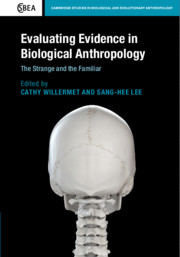Book contents
- Evaluating Evidence in Biological Anthropology
- Cambridge Studies in Biological and Evolutionary Anthropology
- Evaluating Evidence in Biological Anthropology
- Copyright page
- Contents
- Contributors
- Introduction
- Part I The Strange and the Familiar
- 1 Women in Human Evolution Redux
- 2 Hegemony and the Central Asian Paleolithic Record
- 3 Anthropology Now
- 4 The Strangeness of Not Eating Insects
- 5 Methods without Meaning
- Part II (Re)Discovery of Evidence
- Index
- References
4 - The Strangeness of Not Eating Insects
The Loss of an Important Food Source in the United States
from Part I - The Strange and the Familiar
Published online by Cambridge University Press: 01 November 2019
- Evaluating Evidence in Biological Anthropology
- Cambridge Studies in Biological and Evolutionary Anthropology
- Evaluating Evidence in Biological Anthropology
- Copyright page
- Contents
- Contributors
- Introduction
- Part I The Strange and the Familiar
- 1 Women in Human Evolution Redux
- 2 Hegemony and the Central Asian Paleolithic Record
- 3 Anthropology Now
- 4 The Strangeness of Not Eating Insects
- 5 Methods without Meaning
- Part II (Re)Discovery of Evidence
- Index
- References
Summary
About half of the world’s countries have cultures that include insects in their diets and there are over 2000 known insect species consumed (Jongema 2017). However, there is a notable lack of insect consumption in the dominant cultures of the USA, Canada, and many members of the European Union that is accompanied by negative attitudes, most notably manifested as disgust (Looy et al. 2014). A common question that follows from this pattern is: Why are insects actively avoided in “western” culture? A satisfactory answer has not been easy to come by.
- Type
- Chapter
- Information
- Evaluating Evidence in Biological AnthropologyThe Strange and the Familiar, pp. 71 - 85Publisher: Cambridge University PressPrint publication year: 2019
References
- 3
- Cited by



